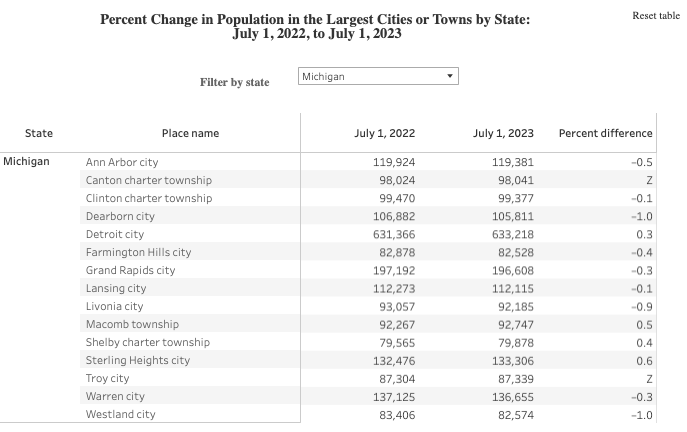It's been 66 years since the Motor City last grew its population. Census data released last month revealed an increase of nearly 2,000 people last year, nearly half the state's population growth.

“Outside of New York, Chicago, and Los Angeles, there is perhaps no more quintessentially American city in this country than Detroit, Michigan,” wrote Rafi Schwartz for The Week on May 29.
At the same time, the past half-century has been challenging for Detroit. The city has lost residents every single year for 66 years. It's been such a precipitous decline that between 1950 and 2010, Detroit's population shrank by a staggering 61%, dropping it from fourth to 27th largest city in the nation.
Indeed, Detroit has often been used as the poster child for America's 'shrinking cities.' No longer.
Schwartz's piece is based on population data released by the U.S. Census Bureau on May 16 (posted here on June 3, “The 15 Fastest-Growing Cities in the US”) that was based on growth in cities and towns from July 1, 2022 to July 1, 2023.
Detroit saw an increase of 1,852 people to 633,218, a 0.3 percent increase, second only to Sterling Heights (0.6 percent), Michigan's fourth most populous city, in percentage gain among the state's larger cities, although Macomb Township and Shelby Charter Township showed slightly higher percentage gains.

“The symbolism [of the population increase] was meaningful in a city that had hollowed out, year after year, since the days when more than 1.8 million people lived there,” reported Julie Bosman, the Chicago bureau chief for The New York Times, on May 16.
City leaders have long promised to reverse Detroit’s long decline in residents brought on by the shrinking of the auto industry, flight to the suburbs and municipal bankruptcy.
The new census estimates showed similar, moderate population rebounds for many big cities in the Midwest and Northeast after previous pandemic-era declines.
State data
The Census national map shows no percentage change in Michigan's population, which saw a slight increase in population that was also worth celebrating, reported Hayley Harding for The Detroit News on Dec. 19, 2023.
“You have to celebrate what you can, even when it's not that big of a win,” said Kurt Metzger, a demographer and the director emeritus of Data Driven Detroit [at Wayne State University].
Related in Planetizen:
- Population Losers, December 28, 2023
- Southern States Lead US Population Growth, December 21, 2023
“In total, new Census Bureau numbers indicate that Michigan has 10,037,261 people, allowing it to hold on to its status as the 10th-largest state by population,” added Harding, noting that the state added 3,980 people from July 1, 2022 to July 1, 2023. The percentage gain rounds to zero, shown by a “Z” on the Census tables.
Detroit accounted for 47% of the growth, with much of the rest coming from adjacent Macomb County, part of northern Metro Detroit.
Challenges ahead
Harding noted that the state ranked 35th among states in growth, well ahead of the eight states that lost population last year, but “behind many of its Midwestern counterparts, including North Dakota (34), Iowa (32), South Dakota (29), Nebraska (27), Wisconsin (20), Minnesota (18), Ohio (16) and Indiana (14).”
Harding added that the Wolverine State has a ways to go.
Since 2020, Michigan is doing even worse compared to its fellow states. Nationally, it ranks 46th for growth from 2020 to 2023, behind only New York, California, Illinois, Louisiana and Pennsylvania. Michigan is down more than 40,000 people from where it was on Census Day in April 2020.
In June 2023, Gov. Gretchen Whitmer created a bipartisan task force, the Growing Michigan Together Council, to reverse the population trajectory. A final report was issued last December describing three strategies “to grow our state’s population and economy while protecting our quality of life and cost of living,” the goal of the task force, according to the governor.

Study: Maui’s Plan to Convert Vacation Rentals to Long-Term Housing Could Cause Nearly $1 Billion Economic Loss
The plan would reduce visitor accommodation by 25,% resulting in 1,900 jobs lost.

North Texas Transit Leaders Tout Benefits of TOD for Growing Region
At a summit focused on transit-oriented development, policymakers discussed how North Texas’ expanded light rail system can serve as a tool for economic growth.

Why Should We Subsidize Public Transportation?
Many public transit agencies face financial stress due to rising costs, declining fare revenue, and declining subsidies. Transit advocates must provide a strong business case for increasing public transit funding.

How to Make US Trains Faster
Changes to boarding platforms and a switch to electric trains could improve U.S. passenger rail service without the added cost of high-speed rail.

Columbia’s Revitalized ‘Loop’ Is a Hub for Local Entrepreneurs
A focus on small businesses is helping a commercial corridor in Columbia, Missouri thrive.

Invasive Insect Threatens Minnesota’s Ash Forests
The Emerald Ash Borer is a rapidly spreading invasive pest threatening Minnesota’s ash trees, and homeowners are encouraged to plant diverse replacement species, avoid moving ash firewood, and monitor for signs of infestation.
Urban Design for Planners 1: Software Tools
This six-course series explores essential urban design concepts using open source software and equips planners with the tools they need to participate fully in the urban design process.
Planning for Universal Design
Learn the tools for implementing Universal Design in planning regulations.
City of Santa Clarita
Ascent Environmental
Institute for Housing and Urban Development Studies (IHS)
City of Grandview
Harvard GSD Executive Education
Toledo-Lucas County Plan Commissions
Salt Lake City
NYU Wagner Graduate School of Public Service





























